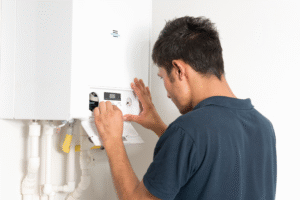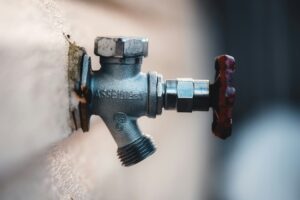Maintaining your home’s plumbing system in Southern California presents unique challenges that change with the seasons. From managing water pressure during drought conditions to preparing for rare but significant rain events, San Diego homeowners face plumbing maintenance needs that differ significantly from those in other regions of the country.
At Solid Plumbing & Drain Inc., we’ve spent 20 years helping homeowners throughout San Diego County develop effective plumbing maintenance routines. We’ve witnessed firsthand how consistent, season-appropriate maintenance can prevent costly emergencies and extend the lifespan of your entire plumbing system.
In this comprehensive guide, you’ll discover practical, season-specific maintenance practices tailored specifically for Southern California homes. These proven approaches address our region’s unique challenges—from hard water to drought conditions—and provide a clear roadmap for keeping your plumbing system functioning optimally throughout the year.
Understanding San Diego’s Unique Plumbing Environment
Before diving into specific maintenance practices, it’s important to understand why San Diego properties face distinctive plumbing challenges compared to homes in other regions.
Water Quality Considerations
San Diego County’s water supply creates specific maintenance needs:
– Extremely hard water (250+ PPM mineral content) accelerates appliance wear and fixture deterioration
– Mineral content varies significantly between water districts, requiring localized approaches
– Seasonal changes in water sources affect mineral composition and treatment chemicals
– Chlorine and chloramine levels fluctuate throughout the year
– pH variations between different water districts affect pipe longevity
– Dissolved solids concentration increases during drought periods
Communities with particularly hard water, such as Rancho Bernardo, Poway, and eastern San Diego County, require more aggressive maintenance approaches than coastal areas with slightly less mineral-laden water.
Climate and Seasonal Factors
Southern California’s distinctive climate influences plumbing maintenance needs:
– Long dry periods followed by occasional intense rain events stress drainage systems
– Extreme temperature variations between coastal and inland areas affect expansion/contraction cycles
– Drought conditions concentrate minerals in water supply, intensifying appliance wear
– Seasonal Santa Ana winds create dust that can affect outdoor plumbing components
– Mild winters mean less concern about freezing but don’t eliminate seasonal maintenance needs
– Coastal salt air accelerates corrosion of exposed metal components
These environmental factors create maintenance patterns that differ significantly from the traditional four-season approach used in other regions.
Local Construction Practices
San Diego’s construction history has created a diverse plumbing landscape:
– Slab foundations with embedded plumbing (common in homes built 1950s-1980s)
– Post-tension concrete slabs that complicate repairs (common in newer developments)
– Multiple plumbing system types within single homes due to partial renovations
– Varying installation quality based on building boom periods
– Regional preferences for certain materials during different construction eras
– Indoor/outdoor lifestyle creating more extensive exterior plumbing than in many regions
These construction factors significantly influence which maintenance approaches are most effective for different San Diego neighborhoods and home styles.
Year-Round Maintenance Fundamentals
Regardless of season, several maintenance practices should be performed consistently throughout the year.
Water Pressure Management
Maintaining appropriate water pressure is fundamental to system longevity:
– Ideal pressure range: 45-65 PSI for most San Diego residential systems
– Test pressure at least quarterly using an inexpensive gauge ($10-15 at hardware stores)
– Install pressure-reducing valves if municipal supply exceeds 70 PSI (common in hillside areas)
– Check pressure after municipal work in your neighborhood
– Adjust pressure seasonally as municipal supply pressure fluctuates
– Document pressure readings to track changes over time
Excessive pressure is particularly common in San Diego’s hillside communities like Del Cerro, Mt. Helix, and La Jolla, where elevation changes require higher municipal pressure that must be regulated for residential use.
Water Heater Maintenance
Water heaters require specific attention in San Diego’s hard water conditions:
– Flush sediment from tank every 6 months (more frequently in areas with extremely hard water)
– Check pressure relief valve quarterly by lifting and releasing the test lever
– Inspect anode rod annually and replace when significantly corroded
– Maintain 120°F temperature setting for efficiency and safety
– Insulate exposed hot water pipes to improve efficiency
– Consider water softener or scale inhibitor for extended water heater life
These practices typically extend water heater lifespan by 5-8 years in San Diego conditions, representing significant savings over premature replacement.
Leak Detection Vigilance
Ongoing leak monitoring prevents water waste and damage:
– Check water meter when no water is being used; movement indicates leaks
– Inspect visible pipes, connections, and fixtures monthly for moisture
– Monitor water bills for unexpected increases
– Place moisture detectors near water heaters and under sinks
– Inspect ceilings below bathrooms regularly for discoloration
– Learn the location of your main water shutoff valve and ensure it operates smoothly
In San Diego’s tiered water pricing environment, even small leaks can significantly impact utility bills while potentially causing structural damage.
Spring Maintenance (March-May)
Spring represents a critical transition period for San Diego plumbing systems as we move from occasional rain to the extended dry season.
Irrigation System Preparation
As watering needs increase, irrigation system maintenance becomes essential:
– Inspect all sprinkler heads for damage from winter growth
– Clean drip irrigation filters and emitters
– Check for leaks in irrigation lines when system is pressurized
– Adjust timers to comply with current water restrictions
– Verify backflow prevention devices are functioning properly
– Consider smart irrigation controllers that adjust to weather conditions
Properly maintained irrigation systems typically use 15-30% less water while providing better coverage, particularly important in San Diego’s water conservation environment.
Drainage System Clearing
After winter rains, drainage maintenance prevents problems during dry months:
– Clear all outdoor drains of debris accumulated during winter
– Snake or hydro-jet interior drain lines to remove buildup
– Clean gutters and downspouts before they dry and harden
– Verify proper drainage away from foundation
– Inspect for erosion around buried pipes from winter rains
– Check sump pumps if present (common in Mission Valley and other low-lying areas)
These practices prevent the hardening of debris during dry months that can create significant blockages when rains eventually return.
Fixture Maintenance
Spring is ideal for addressing fixture issues:
– Descale showerheads and faucet aerators with vinegar solution
– Replace worn toilet flappers and fill valves
– Adjust toilet fill levels to conserve water
– Tighten loose handles and knobs
– Recaulk around tubs, showers, and sinks as needed
– Check washing machine hoses for bulging or cracking
These simple maintenance tasks prevent water waste while extending fixture lifespan in San Diego’s mineral-rich water conditions.
Summer Maintenance (June-September)
Summer’s heat and extended dry periods create specific maintenance needs for San Diego plumbing systems.
Water Conservation Measures
As drought conditions typically intensify, conservation becomes critical:
– Check for toilet leaks using dye tablets or food coloring
– Adjust water pressure downward if possible during peak demand
– Inspect pool and spa plumbing for leaks
– Consider installing aerators on faucets not already equipped
– Verify irrigation system is operating during cooler hours
– Insulate hot water pipes in attics to prevent heat gain
These measures not only conserve water but reduce strain on your plumbing system during peak demand periods.
Outdoor Plumbing Care
Summer heat affects exterior plumbing components:
– Protect exposed pipes from direct sunlight with pipe insulation or shade
– Check hose bibs and outdoor faucets for leaks or drips
– Inspect pool equipment connections and valves
– Clear condensate lines for air conditioning systems
– Verify proper operation of outdoor showers and sinks
– Check irrigation valve boxes for pest intrusion
In San Diego’s intense summer sun, UV degradation and heat stress can damage exterior plumbing components if not properly maintained.
Garbage Disposal Maintenance
Summer entertaining often increases disposal usage:
– Clean disposal monthly with ice cubes and citrus peels
– Avoid disposing of fibrous vegetables and starchy foods
– Run cold water before, during, and after disposal use
– Check for leaks at disposal connections
– Verify proper drainage speed
– Consider professional cleaning for older units
Proper disposal maintenance prevents one of the most common summer emergency calls in San Diego homes, particularly in coastal rental properties with heavy seasonal use.
Fall Maintenance (October-November)
Fall represents another transition period as San Diego prepares for the potential rainy season.
Drainage Preparation
Before winter rains, drainage system preparation is essential:
– Clear all gutters and downspouts of summer debris
– Ensure proper drainage away from foundation
– Snake or hydro-jet main sewer line to remove root intrusion
– Clean all yard drains and area drains
– Check roof and plumbing vents for bird nests or debris
– Verify sump pumps are operational if present
These preparations are particularly important in San Diego’s canyon and hillside communities where drainage issues can quickly escalate to significant problems during heavy rains.
Water Heater Preparation
Fall is ideal for comprehensive water heater maintenance:
– Flush sediment from tank thoroughly
– Check temperature and pressure relief valve
– Inspect for rust or corrosion
– Verify proper temperature setting (120°F recommended)
– Insulate older units with approved water heater blankets
– Consider anode rod replacement if not done within two years
This maintenance timing ensures optimal water heater performance during winter when usage typically increases and cold water inlet temperatures decrease.
Exterior Pipe Protection
While freezing is rare, fall is the time to address exterior pipe vulnerabilities:
– Insulate exposed pipes in unheated areas
– Protect backflow devices with insulating covers
– Repair any pipe insulation damaged during summer
– Secure loose pipes that may be affected by winter winds
– Verify heat tape is functional on pipes in mountain communities
– Drain and winterize outdoor showers if unused during winter
These precautions are particularly important for homes in San Diego’s higher elevations like Julian, Alpine, and Palomar Mountain, where freezing temperatures occasionally occur.
Winter Maintenance (December-February)
San Diego’s mild winters still require specific plumbing attention, particularly during occasional rain events.
Rain Readiness
During San Diego’s rainy season, drainage becomes the priority:
– Monitor drainage systems during initial rains
– Clear drain blockages immediately when detected
– Check for roof leaks around plumbing vents
– Ensure sump pumps remain operational
– Verify downspouts direct water away from foundation
– Consider sandbags for areas prone to flooding (Mission Valley, Sorrento Valley)
Proper drainage maintenance is particularly critical in San Diego’s clay soil areas where poor drainage can lead to foundation issues and underground pipe damage.
Indoor Humidity Management
Winter brings higher indoor humidity levels in many San Diego homes:
– Check for condensation on pipes
– Ensure bathroom exhaust fans operate properly
– Look for signs of mold around plumbing fixtures
– Repair leaky faucets that increase indoor humidity
– Consider dehumidifiers in problem areas
– Address condensation on toilet tanks with insulation kits
These measures prevent mold development and water damage from condensation, particularly in coastal communities with higher ambient humidity.
Vacation Preparation
Winter is a common vacation period for San Diego residents:
– Consider shutting off main water valve during extended absences
– Drain irrigation systems if freezing temperatures are forecast
– Set water heater to “vacation” mode if available
– Arrange for someone to check property periodically
– Leave cabinet doors open under sinks if home will be unheated
– Shut off water to washing machine if leaving for extended periods
These precautions prevent the most common source of significant water damage: leaks that develop while homes are unoccupied.
Neighborhood-Specific Maintenance Considerations
Different San Diego areas benefit from tailored maintenance approaches based on local conditions.
Coastal Communities
For homes in coastal communities from La Jolla to Imperial Beach:
– More frequent inspection of exposed metal components due to salt air corrosion
– Special attention to backflow prevention devices on irrigation systems
– Monitoring for condensation issues due to higher humidity
– More frequent cleaning of fixtures affected by salt air
– Additional protection for outdoor shower plumbing
– Particular vigilance regarding vacation home plumbing when unoccupied
Systems like water softeners and comprehensive filtration show particularly strong return on investment in these areas due to their ability to address both municipal water quality and coastal environmental factors.
Inland Valley Communities
For homes in areas like Clairemont, Mira Mesa, and Tierrasanta:
– More aggressive water heater maintenance due to higher mineral content
– Increased attention to irrigation system efficiency during hot months
– Monitoring for pressure fluctuations common in these areas
– Special attention to drainage before winter rains
– More frequent descaling of fixtures and appliances
– Particular attention to slab leak indicators due to common construction methods
These communities often benefit most from water treatment systems that address San Diego’s hard water conditions, as they typically experience higher mineral content than coastal areas without the extreme levels found in eastern communities.
Eastern County Communities
For homes in areas like El Cajon, Lakeside, and Alpine:
– Extremely aggressive water heater maintenance due to very hard water
– Monitoring for pressure issues during peak demand periods
– Special attention to cooling system condensate lines during hot months
– Preparation for occasional freezing temperatures in higher elevations
– More frequent appliance maintenance due to water quality
– Particular attention to irrigation system efficiency in hotter microclimate
These areas typically see the greatest benefit from whole-house water softening systems due to their extremely hard water conditions that can reduce appliance lifespan by 30-50% if not properly addressed.
Technology-Enhanced Maintenance Approaches
Modern technology offers valuable tools for San Diego homeowners seeking to optimize plumbing maintenance.
Smart Water Monitoring Systems
Connected devices provide enhanced protection:
- Whole-home leak detection systems like Flo by Moen and Phyn Plus monitor water usage in real time and detect hidden leaks
- Smart shutoff valves can automatically turn off the water supply if a major leak is detected while you’re away
- App-based alerts notify homeowners immediately of abnormal water use or pressure fluctuations
- Usage insights help reduce water bills by identifying inefficiencies in irrigation or high-flow fixtures
- Integration with smart home platforms allows for full automation and voice control
These systems are especially valuable for homes in San Diego’s hillside neighborhoods or vacation communities, where early detection can prevent thousands in damage.
A Year-Round Plumbing Plan Built for San Diego Homes
San Diego’s climate, water quality, and building styles demand a maintenance plan tailored to our region’s specific challenges. From managing mineral-rich water in the East County to protecting drainage systems during coastal rains, the key to long-lasting plumbing performance is seasonal awareness and consistent care.
At Solid Plumbing & Drain Inc., we’ve spent over two decades helping homeowners throughout San Diego County create personalized maintenance strategies that reduce emergencies, improve efficiency, and extend the life of every component in their system.
Need help maintaining your plumbing system year-round?



